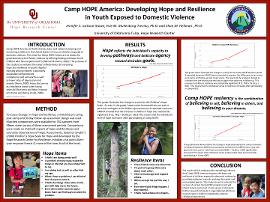| dc.description.abstract | BACKGROUND: Camp HOPE America (www.camphopeamerica.com) is the first local, state, and national camping and mentoring initiative in the United States to focus on children exposed to domestic violence. The vision for Camp HOPE America is to break the generational cycle of family violence by offering healing and hope to children who have witnessed such violence. The purpose of this study is to evaluate the camp's effectiveness at increasing hope and resilience in youth after participating in Camp HOPE.
METHODS: This study utilized pre, post and thirty day follow-up surveys from 1,127 campers at twenty-eight camp sites across fifteen states and their counselors’ observations to examine hope and resilience factors. The surveys were conducted a few days before camp, during camp, and approximately thirty days after the camp ended. To assess hope, the Children’s Hope Scale (Snyder et al., 1997) was utilized to examine the extent to which children believe they can establish pathways to their goals as well as develop and maintain the willpower to follow these pathways. On the first and last day of camp, counselors also provided assessments of 1,063 campers using the Children's Hope Scale, reworded to reflect this observational approach. Following the Camp HOPE America theme of believing in yourself, believing in others and believing in your dreams, OU's Hope Research Center created six items to assess each child's self-reported resiliency. For both hope and resilience, a six point Likert-type response format was utilized (1=none of the time; 6=all of the time).
RESULTS: Hope and Resiliency scores increased from pre-camp test to at-camp test and again at the 30-day follow-up assessment. Repeated measures ANOVAS showed that the increase was statistically significant for both hope [F(2,781)=36.80; p<.001] and resilience [F (2, 769)=26.34; p<.001]. In regard to hope observed by the camp counselors, a repeated measures ANOVA was computed to examine the differences in pre-camp and at-camp test mean scores [t(1062)=-16.66; p<.001] and showed that individuals' levels of observable hope increased after participating in Camp HOPE America.
CONCLUSION: The results of this study provide compelling evidence that Camp HOPE improves the hope of children exposed to domestic violence and their resilience. This study serves to evaluate the success of current camp programming and will inform future curriculum and programming for Camp HOPE America. It also serves to stimulate further interest in organizations' ability to nourish hope and resilience in children impacted by domestic violence. | en_US |

